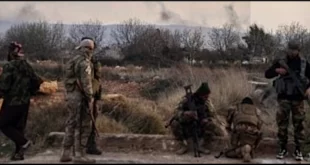Sep 20, 2013, Strategic Culture
Each expert has his own assessment of Washington’s maneuvers around Syria and his own understanding of the aims of these maneuvers. There are as many understandings of the war being waged against Syria as there are experts writing on the topic of the Syrian crisis.For example:
1) providing the United States with energy resources;
2) creating controlled chaos in order to control the Middle Eastern region;
3) protecting the interests of the closest ally of the U.S., Israel;
4) using Syria as a “trigger” in order to stir up the flame of regional war which will then grow into a world war;
5) boosting the falling ratings of the American president;
6) giving Washington more effective control over China and European countries, which are dependent on supplies of energy resources from the Middle East.
7) occupying Syria in order to move on to the destruction of a more important U.S. foe, Iran;
8) ensuring contracts for the American defense industry and making the “arms barons” rich;
9) stimulating the stagnant American economy through military spending;
10) distracting Americans from unemployment, poverty and U.S. foreign policy failures, justifying the actions of intelligence agencies in monitoring the population of the U.S., etc.
In trying to clarify the true aims of Washington’s escalation of tensions around Syria when there are so many different expert opinions, one must not take the words of Barack Obama seriously. We will presume that the president has no understanding of the overall plan with regard to Syria. Nor do the Pentagon or American battlefield generals… At recent hearings in the U.S. Congress, four-star general Martin Dempsey, the Chairman of the Joint Chiefs of Staff, answered Senator Bob Corker’s question on what he was seeking to achieve during a Syrian campaign with soldierly forthrightness and honesty: “I can’t answer that, what we’re seeking.”
“Peace and Safety” through War
In my opinion, three main interconnected aims can be identified among Washington’s hierarchy of aims in the “Syrian project”:
a) to pave the aggressor’s way to the borders of Russia;
b) to create the conditions for starting World War III;
c) to preserve the petrodollar currency system.
Much has already been said about the fact that Syria is merely an intermediate link in Washington’s aggressive plans. After Syria, the next target of aggression is to be Iran. And after Iran, the aggressor will end up right on the southern borders of Russia.
And now for the second strategic aim. Note that I say not to start World War III, but to create the conditions for starting it. The nuance is that the United States doesn’t need World War III at the moment. However, it could be needed in the near future. What for? However unexpected it may sound, the answer to this question lies in the mystical realm; there is no purely rational answer. The heart of the matter is that the masters of the Federal Reserve system, who dictate their will to America, have an inflamed sense of religion: they consider themselves to be forerunners of the Mashiach (Messiah), and expect that when he comes into the world, the Mashiach will ascend to the throne in the Temple of Jerusalem, which is yet to be rebuilt. A regional war in the Middle East is needed by the masters of the Federal Reserve precisely because, in their minds, it will make it possible to rebuild the Third Temple in Jerusalem. A regional war started in one of the most explosive parts of the planet could easily grow into a world war, spreading chaos throughout the world. This will be the kind of chaos which will force all nations, upon seeing it, to pray that “peace and safety” would be established in the world. That is when the “last days” will come, and the majority of people will joyfully welcome the coming of the Mashiach (in the Christian worldview, the antichrist), who will reveal himself as the guarantor of “peace and safety”.
War as a Way to Nullify Debts
Incidentally, there is a simplified explanation for why Washington might need World War III. This is the “financial” theory, which is adapted to the atheistic consciousness of the ruling elite of the West. Such a war is meant to nullify the astronomical debts run up by the U.S. and the West, as well as the banks of Wall Street and London City, which are in debt to all of humanity. The sovereign debt of the U.S. has already exceeded 100% of the GDP, and the country’s external debt has also topped 100% of the GDP. Europe has been suffering from a serious debt crisis for several years, and no end is in sight. The sovereign debt of the Eurozone countries is inexorably approaching 100% of the GDP. The situation with external debt is even more critical. In Great Britain, for example, the external debt has approached the level of 500% of the GDP. Such indebtedness makes Europe an unwilling ally of Washington in its military ventures. The war, as the usurious bankers explain to the politicians, should “write off” all these debts. Otherwise, it will be the end not only of the banks, but of many states in the “golden billion”.
The mechanisms for “writing off” debts are varied. Some debtors may vanish from the map altogether as a result of the war. There’s a well-known saying among usurers: “If there’s no debtor, there’s no debt”. To others they may explain that their debt claims against America are annulled in order to cover Washington’s expenses for “defending democracy” on a global scale. Yet others may be turned from debt holders to debtors by imposing indemnities and reparations on them as enemies or abettors of the enemies of “world democracy”. Basically, Uncle Sam should come out of the war debt-free. That is what his closest allies are counting on as well, especially Great Britain. And then Washington dreams of entering the “river of history” once more as the victor in the latest world war, with all the advantages that entails. However, the scenario of world war will only be launched if it is no longer possible to maintain the debt pyramid in America. For now the U.S. military and banking system, straining with all its might, is trying to maintain and expand it.
Washington Needs the Petrodollar, not Petroleum
And now for the third strategic goal – preserving the petrodollar system. It is well known that forty years ago the gold standard was replaced by the oil standard. In 1971 the U.S. announced the end of the convertibility of the dollar to gold. Two years later, in order to support world demand for the U.S. dollar, which was no longer backed by anything, a new system was created: the petrodollar. In 1973 an agreement was reached between Saudi Arabia and the U.S. according to which each barrel of oil bought from Saudi Arabia would be priced in U.S. dollars. In accordance with this new agreement, any country wishing to buy oil from Saudi Arabia must first exchange its own national currency for American dollars. In exchange for Saudi Arabia’s willingness to conduct oil deals exclusively in U.S. dollars, America offered it arms and protection of oil fields from the encroachment of neighboring countries, including Israel.In 1975 all the OPEC countries agreed to price their oil resources exclusively in American dollars and receive dollars for oil. In exchange they were promised arms shipments and military protection.
The petrodollar system which took shape forty years ago is doubly profitable to Washington. First, Federal Reserve banks receive income from each dollar issued (it is, after all, credit money, which creates debts). Thus banks rake in fabulous profits; a few crumbs fall to the American “rabble” as well. Second, all transactions in dollars are conducted through U.S. banks; consequently, Washington has an effective mechanism for controlling its vassals which are part of the world petrodollar system.
Sometimes people say that in the Middle East America is fighting for sources of uninterrupted oil supplies for its economy. With regard to the events of 2013 surrounding Syria this theory is simply incorrect, although it was still justifiable at the time of the American invasion of Iraq. In his memoirs, published in 2007, former head of the Federal Reserve Alan Greenspan writes: “I am saddened (!) that it is politically inconvenient to acknowledge what everyone knows: the Iraq war is largely about oil.” That same year the current U.S. Secretary of Defense, then-Senator Chuck Hagel, admitted: “People say we’re not fighting for oil. Of course we are.”
Over the past several years America has been solving its energy problems fairly effectively through the so-called “shale revolution”. Its dependence on external sources is getting lower every year. America is no longer trying to create regimes under its control in the Arab world whose task is to provide an uninterrupted supply of oil and gas to the U.S. Today imports of oil from North Africa and the Middle East make up only 10% of total oil consumption in the U.S., and over the next few years that figure could fall to zero. Washington is fighting for trade in these resources to be conducted in U.S. dollars. The masters of the Federal Reserve system have a direct interest in this. Now, for example, China is establishing increasingly close relations with Iran, in spite of sanctions. What irritates Washington (or rather, the masters of the Fed) most of all is that trade between the two countries is conducted not in U.S. dollars, but on the basis of barter, clearing, and national currency units. No one voluntarily wants to trade energy resources for dollars anymore. Now it can only be done under the pressure of force – primarily on producers and exporters.
The Fight for the Petrodollar is Escalating
Iraq, Libya, Syria, Iran – these are the links in Washington’s fight to preserve the petrodollar. Let us recall some almost forgotten facts. In early 2011, Syrian President Bashar al-Asad announced the beginning of collaboration with Russia and China, in accordance with which all oil transactions were to be conducted in rubles and yuans. In March 2011 anti-government disturbances aimed at overthrowing the existing regime began, and on November 15 an embargo on the export of Syrian oil came into force.On June 1, 2012 an embargo came into force on the export of Iranian oil, which Tehran had begun selling for euros and rials, focusing on the internal exchange.
The situation was becoming increasingly tense for the masters of the Fed. In early 2013 the share of the dollar in international transactions fell below the psychologically important 50% mark. This was a serious signal to the masters of the Fed. Other countries may also end up on Washington’s “execution list”. These are countries which trade using: a) barter; b) clearing; c) gold; d) national currency units. For example, India and China buy oil from Iran for gold. Washington is unable to force India and China to abandon this kind of trade, but it hopes to get the better of Iran. It is also very unpleasant for Washington that Moscow is becoming increasingly confident in using the ruble for trade with neighboring countries. Russia is more and more frequently making contracts with China in rubles and yuans. Beijing is transitioning to transactions in yuans even with Western European countries. Is that not a reason for Washington to consider Russia and China its serious adversaries? So Uncle Sam is trying to make its way to the borders of Russia via Syria and Iran not only for geopolitical reasons, but for purely financial reasons as well. Everyone who undermines the petrodollar standard must be punished!
And only when Washington’s fight to preserve the petrodollar system becomes hopeless will it implement “plan B”, also called “World War III”. And the detonator for this war is in the Middle Eastern region, more specifically, in Syria and Iran.
 Syria Support Movement solidarity with the Syrian people
Syria Support Movement solidarity with the Syrian people





